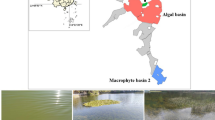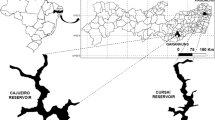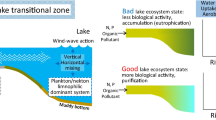Abstract
Understanding the biodiversity value of littoral zones of lakes is a priority for aquatic biodiversity conservation. However, less emphasis has been given to the littoral part of tropical African lakes, with many of the previous researches focusing only on the open water side. The aim of the present study was, therefore, to investigate the impact of the littoral zone of a shallow freshwater tropical lake (Ziway, Ethiopia), dominated by two emergent macrophytes, on zooplankton community structure. We hypothesized that the wetland vegetation serves as a preferred microhabitat for zooplankton communities. A lake with substantial coverage of emergent macrophytes was monitored monthly from January to August, 2016. The monitoring included the measurements of physical, chemical, and biological parameters. Sampling sites were selected to represent areas of the macrophyte vegetation (Typha latifolia and Phragmites australis) and the open water part of the lake. Sites with macrophyte vegetation were found to be the home of more dense and diverse zooplankton community. However, during the period of high vegetation loss, the density of crustacean zooplankton showed significant reduction within the patches of macrophytes. From biodiversity conservation perspective, it was concluded that the preservation of such small areas of macrophytes covering the littoral zone of lakes could be as important as protecting the whole lake. However, the rapid degradation of wetland vegetation by human activities is a real threat to the lake ecosystem. In the not-too-far future, it could displace and evict riparian vegetation and the biota it supports.




Similar content being viewed by others
References
APHA (2005) Standard methods for the examination of water and wastewater. American Public Health Association (APHA): Washington DC
Arcifa MS, Perticarrari A, Bunioto TC, Domingos AsR, Minto WJ (2016) Microcrustaceans and predators: diel migration in a tropical lake and comparison with shallow warm lakes. Limnetica 35:281–296
Asaeda T, Trung VK, Manatunge J (2000) Modeling the effects of macrophyte growth and decomposition on the nutrient budget in shallow lakes. Aquat Bot 68:217–237
Ayenew T, Legesse D (2007) The changing face of the Ethiopian rift lakes and their environs: call of the time. Lakes Reserv 12:149–165
Baattrup-Pedersen A, Larsen SrE, Riis T (2003) Composition and richness of macrophyte communities in small Danish streams-influence of environmental factors and weed cutting. Hydrobiologia 495:171–179
Barker T, Irfanullah H, Moss B (2010) Micro-scale structure in the chemistry and biology of a shallow lake. Freshw Biol 55:1145–1163
Beneberu G, Mengistou S (2010) Oligotrophication trend of Lake Ziway, Ethiopia. SINET 32:141–148
Burks R, Lodge D, Jeppesen E, Lauridsen T (2002) Diel horizontal migration of zooplankton: costs and benefits of inhabiting the littoral. Freshw Biol 47:343–365
Cazzanelli M, Warming TP, Christoffersen KS (2008) Emergent and floating-leaved macrophytes as refuge for zooplankton in a eutrophic temperate lake without submerged vegetation. Hydrobiologia 605:113–122
Choi J-Y, Jeong K-S, Kim S-K, La G-H, Chang K-H, Joo G-J (2014) Role of macrophytes as microhabitats for zooplankton community in lentic freshwater ecosystems of South Korea. Ecol Inform 24:177–185
Cottenie K, Nuytten N, Michels E, De Meester L (2001) Zooplankton community structure and environmental conditions in a set of interconnected ponds. Hydrobiologia 442:339–350
Cronin G, Lewis WM, Schiehser MA (2006) Influence of freshwater macrophytes on the littoral ecosystem structure and function of a young Colorado reservoir. Aquat Bot 85:37–43
Dagne A, Herzig A, Jersabek CD, Tadesse Z (2008) Abundance, species composition and spatial distribution of planktonic rotifers and crustaceans in Lake Ziway (Rift Valley, Ethiopia). Int Rev Hydrobiol 93:210–226
De Meester L, Declerck S, Janse JH, Dagevos JJ, Portielje R, Lammens E, Jeppesen E, Lauridsen T, Schwenk K, Muylaert K (2006) Biodiversity in European shallow lakes: a multilevel-multifactorial field study. In: Bobbink R, Beltman B, Verhoeven JTA, Whigham DF (eds) Wetlands: Functioning, biodiversity conservation, and restoration. Springer Verlag, Berlin, p 149–167
Degefu F, Schagerl M (2015) Zooplankton abundance, species composition and ecology of tropical high-mountain crater Lake Wonchi, Ethiopia. J Limnol 74:324–334
Dejen E, Vijverberg J, Nagelkerke LA, Sibbing FA (2004) Temporal and spatial distribution of microcrustacean zooplankton in relation to turbidity and other environmental factors in a large tropical lake (L. Tana, Ethiopia). Hydrobiologia 513:39–49
Dejenie T, Declerck SA, Asmelash T, Risch S, Mergeay J, De Bie T, De Meester L (2012) Cladoceran community composition in tropical semi-arid highland reservoirs in Tigray (Northern Ethiopia): a metacommunity perspective applied to young reservoirs. Limnologica 42:137–143
Dudgeon D, Arthington AH, Gessner MO, Kawabata Z-I, Knowler DJ, Lévêque C, Naiman RJ, Prieur-Richard AH, Soto D, Stiassny ML (2006) Freshwater biodiversity: importance, threats, status and conservation challenges. Biol Rev 81:163–182
Dudley T (1988) The roles of plant complexity and epiphyton in colonization of macrophytes by stream insects. Verh Internat Verein Limnol 23:1153–1158
Dudley T, Collins L (1995) Biological invasions in California wetlands: the impacts and and control of non-indigenous species (NIS) in natural areas. Pacific Institute for Studies in Development, Environment, and Security. Oakland, CA
Edward GB, David CS (2010) Freshwater algae identification and use as bioindicators. A John Wiley & Sons, Ltd, p 101
Fernando CH, Kutikova LA, Korinek V, Alekseev VR (2002) Guide to tropical freshwater zooplankton: identification, ecology and impact on fisheries. In: Fernando CH (ed) Guide to tropical freshwater zooplankton: identification, ecology and impact on fisheries. Backhuys Publishers. Lieden, The Netherlands
Fetahi T, Mengistou S, Schagerl M (2011) Zooplankton community structure and ecology of the tropical-highland Lake Hayq, Ethiopia. Limnologica 41:389–397
Gebrehiwot M, Kifle D, Stiers I, Triest L (2017) Phytoplankton functional dynamics in a shallow polymictic tropical lake: the influence of emergent macrophytes. Hydrobiologia 797:69–86
Genkai-Kato M (2007) Macrophyte refuges, prey behavior and trophic interactions: consequences for lake water clarity. Ecol Lett 10:105–114
Genkai-Kato M, Carpenter SR (2005) Eutrophication due to phosphorus recycling in relation to lake morphometry, temperature, and macrophytes. Ecology 86:210–219
Gillooly JF, Dodson SI (2000) Latitudinal patterns in the size distribution and seasonal dynamics of new world, freshwater cladocerans. Limnol Oceanogr 45:22–30
Goldsborough LG, McDougal RL, North AK (2005) Periphyton in freshwater lakes and wetlands. In: Azim ME et al (eds) Periphyton: Ecology, Exploitation and Management, p 71–89. CABI Publishing, London
Gyllström M, Hansson L-A (2004) Dormancy in freshwater zooplankton: induction, termination and the importance of benthic-pelagic coupling. Aquat Sci 66:274–295
Hansen JP, Wikström SA, Axemar H, Kautsky L (2011) Distribution differences and active habitat choices of invertebrates between macrophytes of different morphological complexity. Aquat Ecol 45:11–22
Iglesias C, Mazzeo N, Meerhoff M, Lacerot G, Clemente JM, Scasso F, Kruk C, Goyenola G, García-Alonso J, Amsinck SL (2010) High predation is of key importance for dominance of small-bodied zooplankton in warm shallow lakes: evidence from lakes, fish exclosures and surface sediments. Hydrobiologia 667:133–147
Jeppesen E, Jensen JP, Søndergaard M, Lauridsen T, Pedersen LJ, Jensen L (1997) Top–down control in freshwater lakes: the role of nutrient state, submerged macrophytes and water depth. Hydrobiologia 342:151–164
Jeppesen E, Meerhoff M, Holmgren K, González-Bergonzoni I, Teixeira-de Mello F, Declerck SA, De Meester L, Søndergaard M, Lauridsen TL, Bjerring R (2010) Impacts of climate warming on lake fish community structure and potential effects on ecosystem function. Hydrobiologia 646:73–90
Jeppesen E, Søndergaard M, Mazzeo N, Meerhoff M, Branco C, Huszar V, Scasso F (2005) Lake restoration and biomanipulation in temperate lakes: relevance for subtropical and tropical lakes. In: Reddy V (ed) Restoration and Management of Tropical Eutrophic Lakes, p 341–359. Science Publishers, Inc., Enfield
Joniak T, Kuczyńska-Kippen N, Nagengast B (2007) The role of aquatic macrophytes in microhabitatual transformation of physical-chemical features of small water bodies. Hydrobiologia 584:101–109
Lauridsen T, Jeppesen E, Landkildehus F, Søndergaard M (2001) Horizontal distribution of cladocerans in arctic Greenland lakes-impact of macrophytes and fish. Hydrobiologia 442:107–116
Legendre P, Gallagher ED (2001) Ecologically meaningful transformations for ordination of species data. Oecologia 129:271–280
Legesse D, Vallet-Coulomb C, Gasse F (2001) Precipitation-runoff modeling in the Ziway-Shala Basin, Ethiopian Rift Valley. In: PAGES, International conference on past climate variability through Europe and Africa, Aix-en-Provence. p 27–31
Liu G, Liu Z, Chen F, Zhang Z, Gu B, Smoak JM (2013) Response of the cladoceran community to eutrophication, fish introductions and degradation of the macrophyte vegetation in Lake Dianchi, a large, shallow plateau lake in southwestern China. Limnology 14:159–166
Madsen JD, Chambers PA, James WF, Koch EW, Westlake DF (2001) The interaction between water movement, sediment dynamics and submersed macrophytes. Hydrobiologia 444:71–84
Magalhhães Braghin LdS, Simões NR, Bonecker CC (2016) Hierarchical effects of local factors on zooplankton species diversity. Inland Waters 6:645–654
Men Y-J, Hu H-Y, Li F-M (2007) Effects of the novel allelochemical ethyl 2-methylacetoacetate from the reed (Phragmitis australis Trin) on the growth of several common species of green algae. J Appl Phycol 19:521–527
Mergeay J, Verschuren D, Kerckhoven LV, Meester LD (2004) Two hundred years of a diverse Daphnia community in Lake Naivasha (Kenya): effects of natural and human-induced environmental changes. Freshw Biol 49:998–1013
Moreira RA, Rocha O, dos Santos RM, Dias ES, Moreira FWA, Eskinazi-Sant’Anna EM (2016) Composition, body-size structure and biomass of zooplankton in a high-elevation temporary pond (Minas Gerais, Brazil). Oecol Aust 20:81–93
Murrell MC, Lores EM (2004) Phytoplankton and zooplankton seasonal dynamics in a subtropical estuary: importance of cyanobacteria. J Plankton Res 26:371–382
Obertegger U, Flaim G, Braioni MG, Sommaruga R, Corradini F, Borsato A (2007) Water residence time as a driving force of zooplankton structure and succession. Aquat Sci 69:575–583
OECD (1982) Eutrophication of waters, monitoring, assessment and control: OECD cooperative program on monitoring of inland waters (eutrophication control). Environmental Directorate, Paris
Peters JA, Lodge DM (2009) Invasive species policy at the regional level: a multiple weak links problem. Fisheries 34:373–380
Rolon AS, Homem HF, Maltchik L (2010) Aquatic macrophytes in natural and managed wetlands of Rio Grande do Sul State, Southern Brazil. Acta Limnologica Brasiliensia 22:133–146
Rooney N, Kalff J (2003) Submerged macrophyte-bed effects on water-column phosphorus, chlorophyll a, and bacterial production. Ecosystems 6:797–807
Sandercock G, Scudder G (1994) An introduction and key to the freshwater calanoid copepods (Crustacea) of British Columbia. Technical report, Resources Inventory Committee Publications, British Columbia
Scheffer M (1999) The effect of aquatic vegetation on turbidity; how important are the filter feeders? Shallow Lakes’ 98:307–316.
Schröder R (1984) An attempt to estimate the fish stock and the sustainable yield of Lake Ziway and Lake Abaya, Ethiopian Rift Valley. Archiv für Hydrobiologie Supplementband Monographische Beiträge 69:411–441
Sharma RC, Rawat JS (2009) Monitoring of aquatic macroinvertebrates as bioindicator for assessing the health of wetlands: a case study in the Central Himalayas, India. Ecol Indic 9:118–128
Solimini A, Cardoso A, Heiskanen A (2006) Indicators and method for ecological status assessment under water framework development. European Commission: Joint Reseach Center, EUR22314EN, Luxemburg
Sousa W, Attayde JL, Rocha EDS, Eskinazi-Sant’Anna EM (2008) The response of zooplankton assemblages to variations in the water quality of four man-made lakes in semi-arid northeastern Brazil. J Plankton Res 30:699–708
StatSoft I (2008) STATISTICA (data analysis software system), version 8. Tulsa
Stevenson RJ, Hauer FR (2002) Integrating hydrogeomorphic and index of biotic integrity approaches for environmental assessment of wetlands. J N Am Benthol Soc 21:502–513
Tamire G, Mengistou S (2013) Macrophyte species composition, distribution and diversity in relation to some physicochemical factors in the littoral zone of Lake Ziway, Ethiopia. Afr J Ecol 51:66–77
ter Braak CJ, Smilauer P (1998) CANOCO reference manual and CanoDraw for Windows user’s guide: software for canonical community ordination (version 4.5): www.canoco.com
Thomaz SM, Dibble ED, Evangelista LR, Higuti J, Bini LM (2008) Influence of aquatic macrophyte habitat complexity on invertebrate abundance and richness in tropical lagoons. Freshw Biol 53:358–367
Tilahun G, Ahlgren G (2010) Seasonal variations in phytoplankton biomass and primary production in the Ethiopian Rift Valley lakes Ziway, Awassa and Chamo-The basis for fish production. Limnologica 40:330–342
Vallet-Coulomb C, Legesse D, Gasse Fo, Travi Y, Chernet T (2001) Lake evaporation estimates in tropical Africa (Lake Ziway, Ethiopia). J Hydrol 245:1–18
van Donk E, van de Bund WJ (2002) Impact of submerged macrophytes including charophytes on phyto-and zooplankton communities: allelopathy versus other mechanisms. Aquat Bot 72:261–274
Van Onsem S, De Backer S, Triest L (2010) Microhabitat-zooplankton relationship in extensive macrophyte vegetations of eutrophic clear-water ponds. Hydrobiologia 656:67–81
Wetzel R, Likens G (2000) Limnolgical analysis. WB Saunders Co, Philadelphia
Witty LM (2004) Practical guide to identifying freshwater crustacean zooplankton. Cooperative Freshwater Ecology Unit, Sudbury, Ontario
Wondifraw AM (2008) School of graduate studies faculty of technology department of civil engineering: Addis Ababa University, Ethiopia
Zeray L, Roehrig J, Chekol DA (2006) Climate change impact on Lake Ziway watershed water availability, Ethiopia. University of Applied Sciences Cologne, Germany
Zhang T-T, Hu W, Zhang D (2012) Allelopathic effect of Typha angustifolia L. on phytoplankton. Advanced Materials Research 383:3724–3728
Acknowledgements
The authors would like to acknowledge Vlaamse Interuniversitaire Raad-Universitaire Ontwikkelingssamenwerking (VLIR-UOS PhD scholarship for Mesfin Gebrehiwot), Vrije Universiteit Brussel (VUB-BAS42) and Addis Ababa University for their financial and logistic support.
Author information
Authors and Affiliations
Corresponding author
Ethics declarations
Conflict of Interest
The authors declare that they have no competing interests.
Electronic supplementary material
Rights and permissions
About this article
Cite this article
Gebrehiwot, M., Kifle, D. & Triest, L. Emergent Macrophytes Support Zooplankton in a Shallow Tropical Lake: A Basis for Wetland Conservation. Environmental Management 60, 1127–1138 (2017). https://doi.org/10.1007/s00267-017-0935-z
Received:
Accepted:
Published:
Issue Date:
DOI: https://doi.org/10.1007/s00267-017-0935-z




